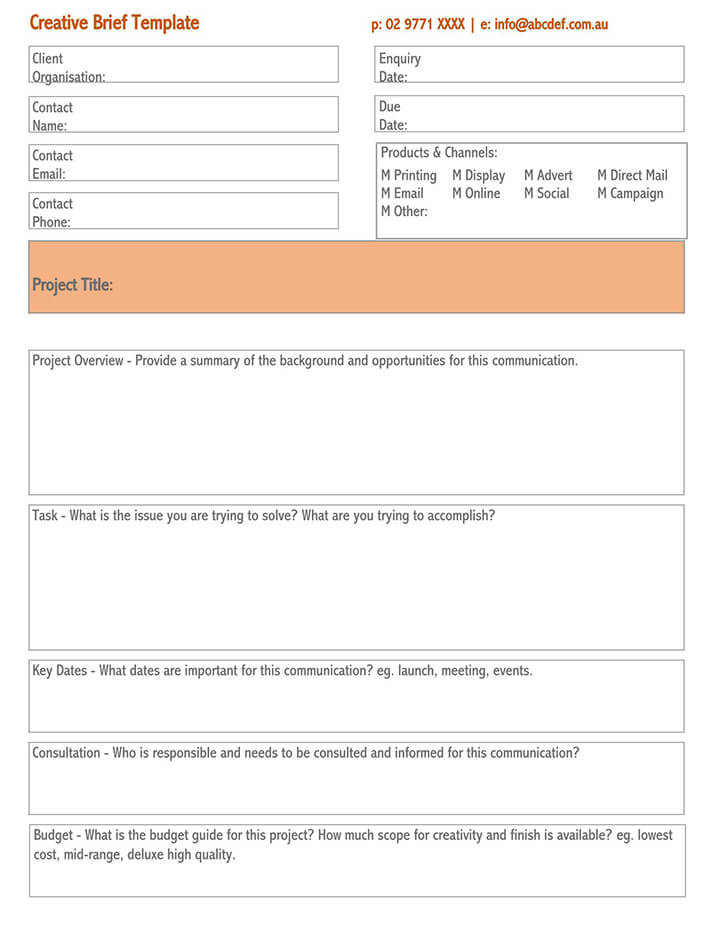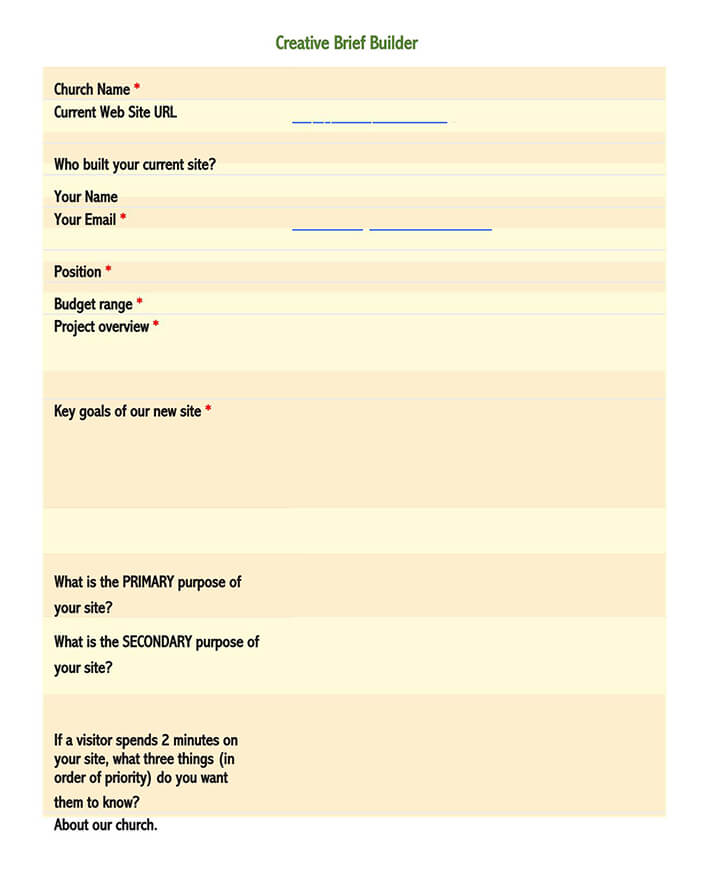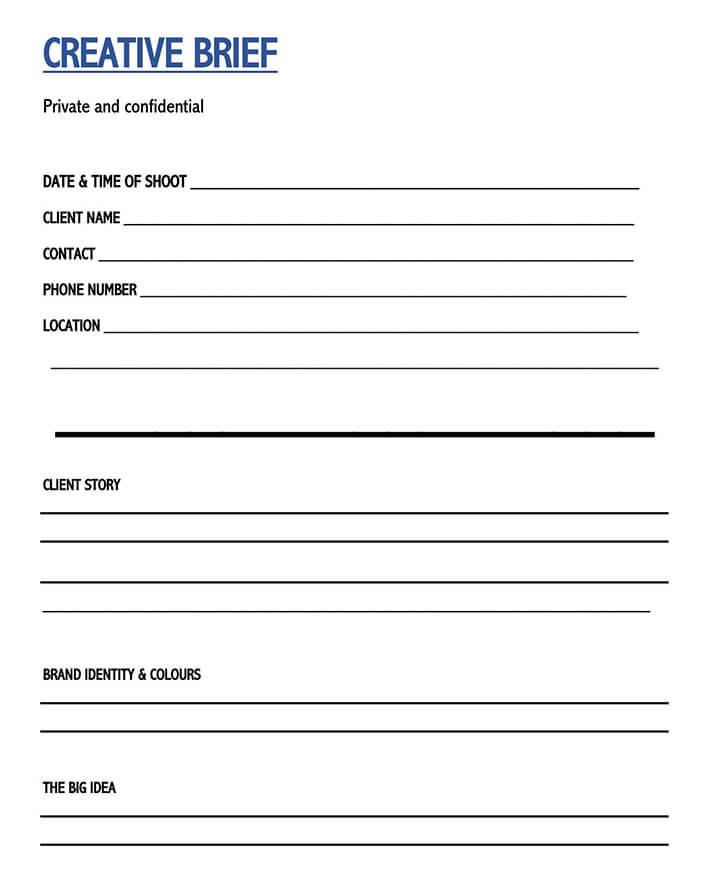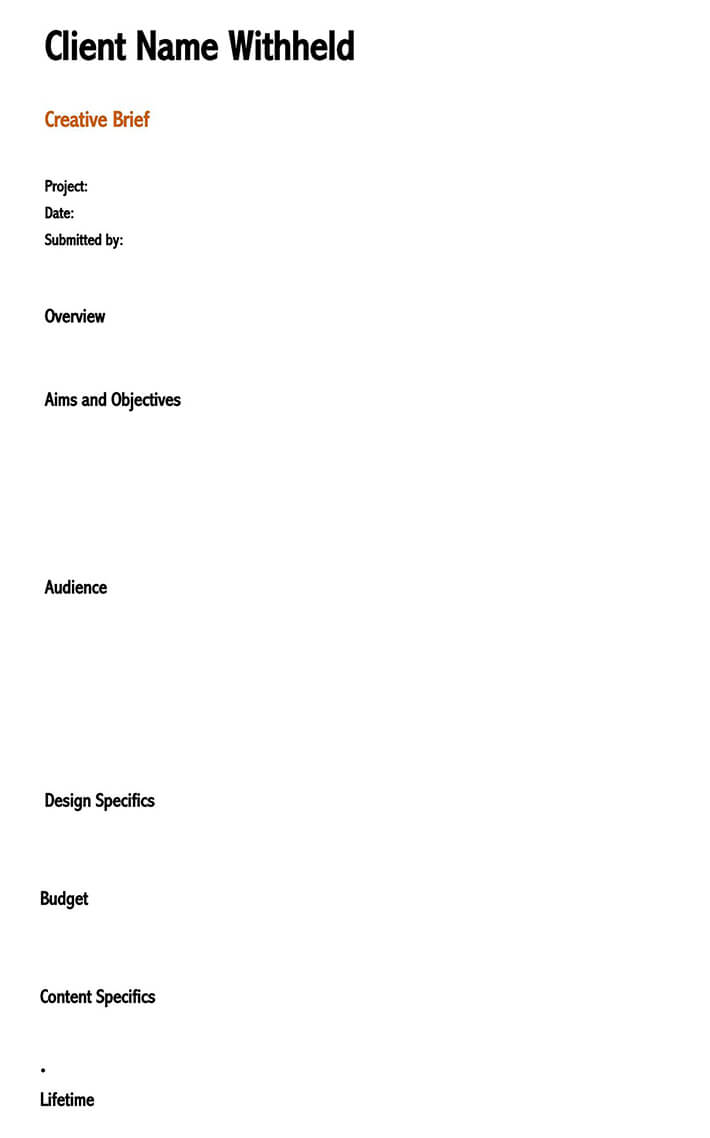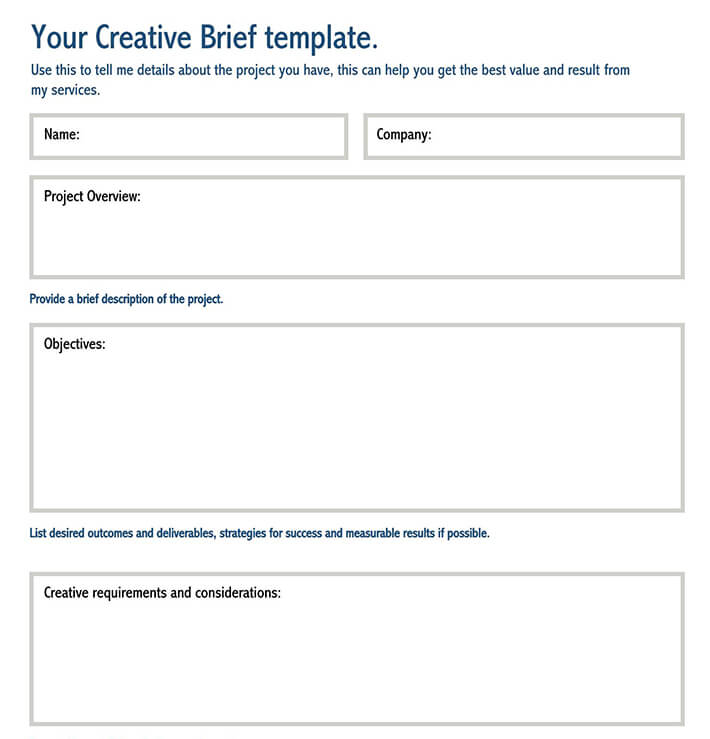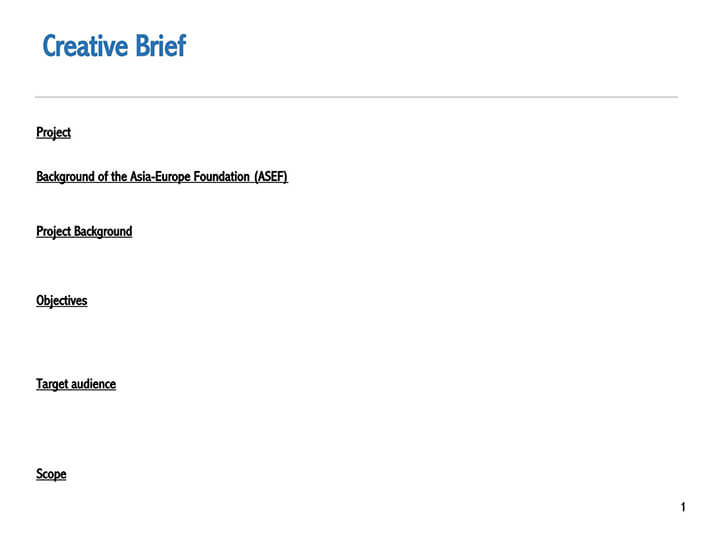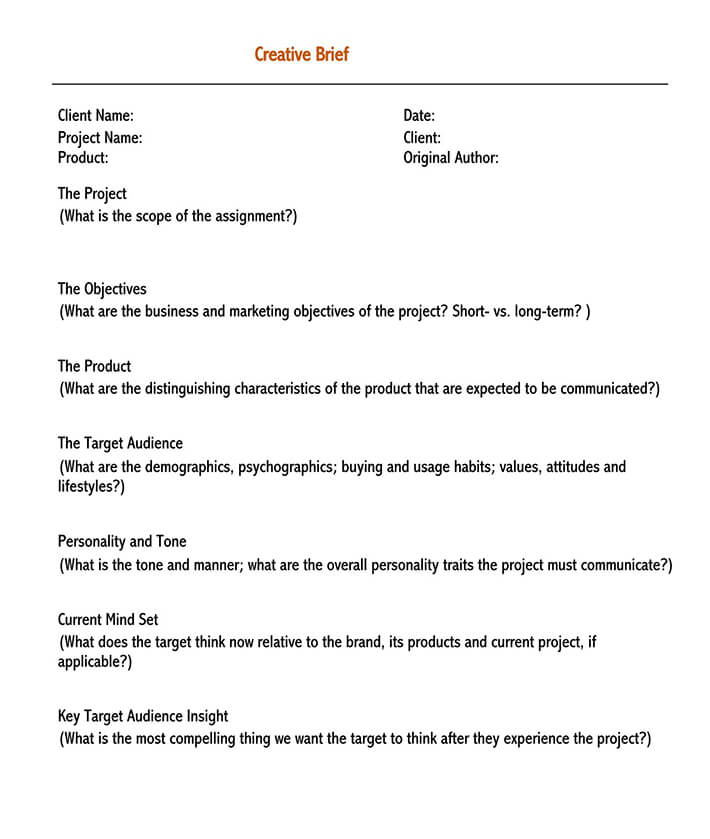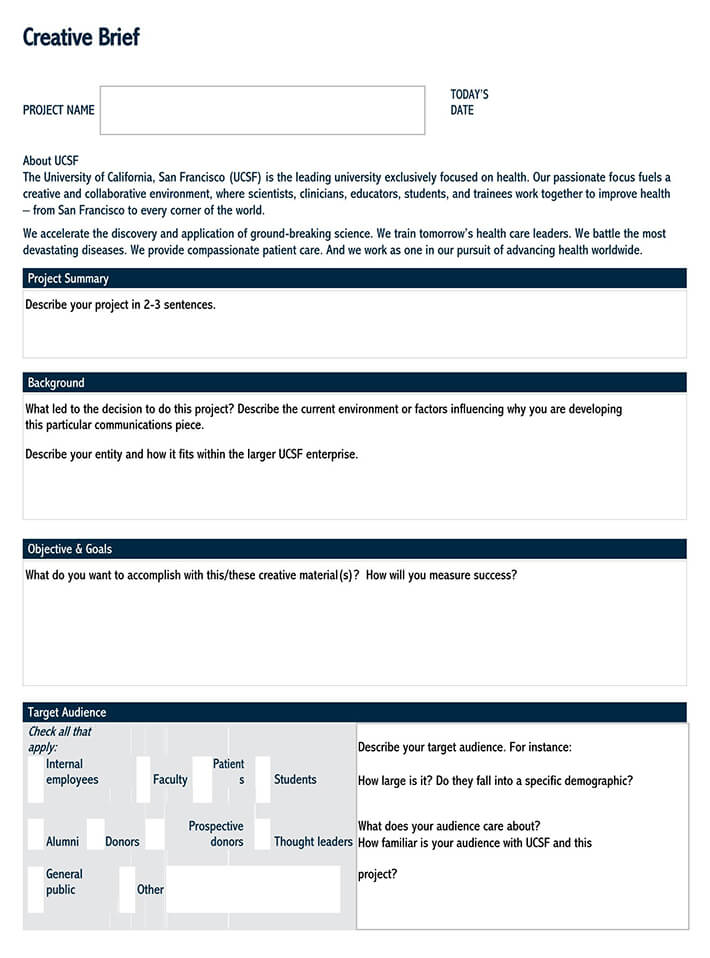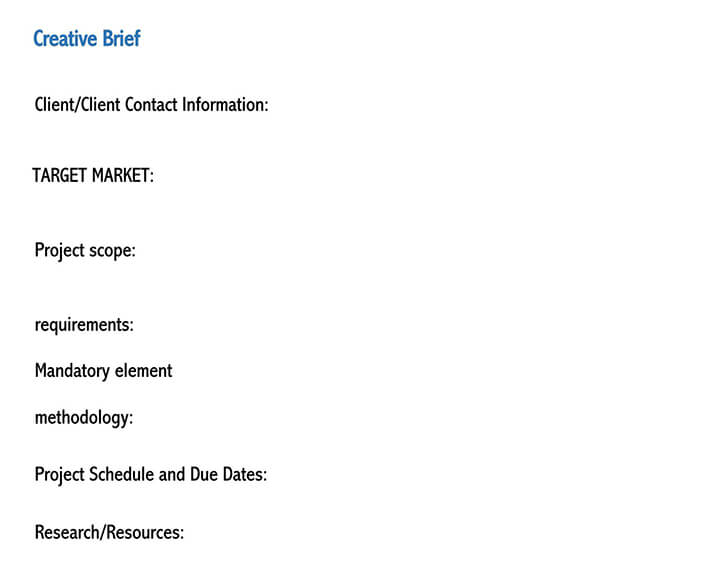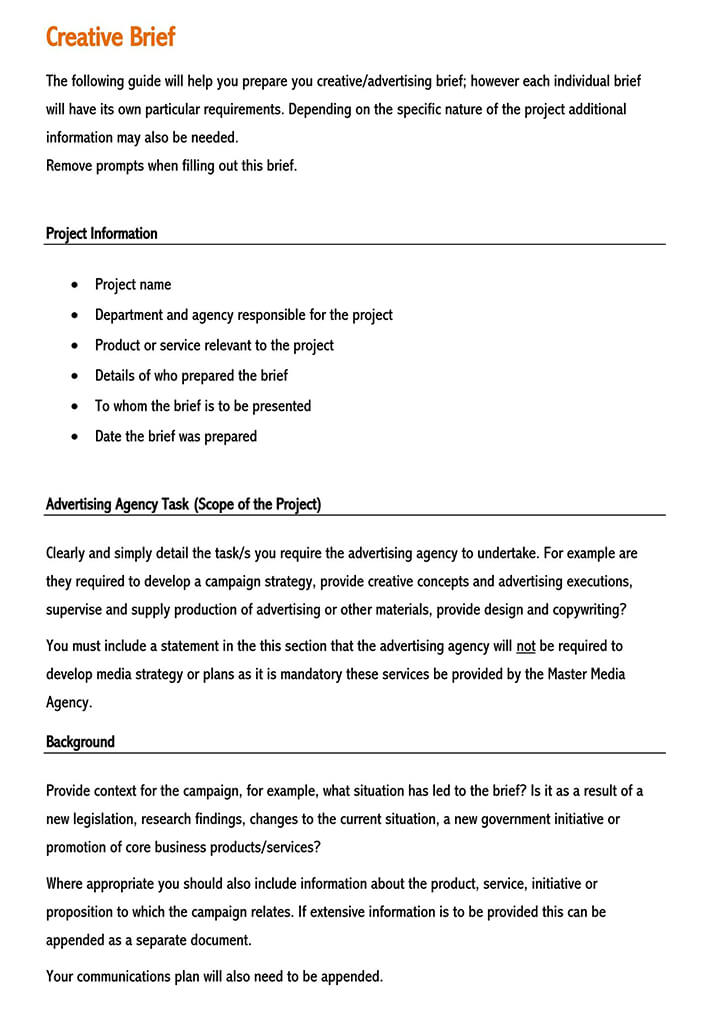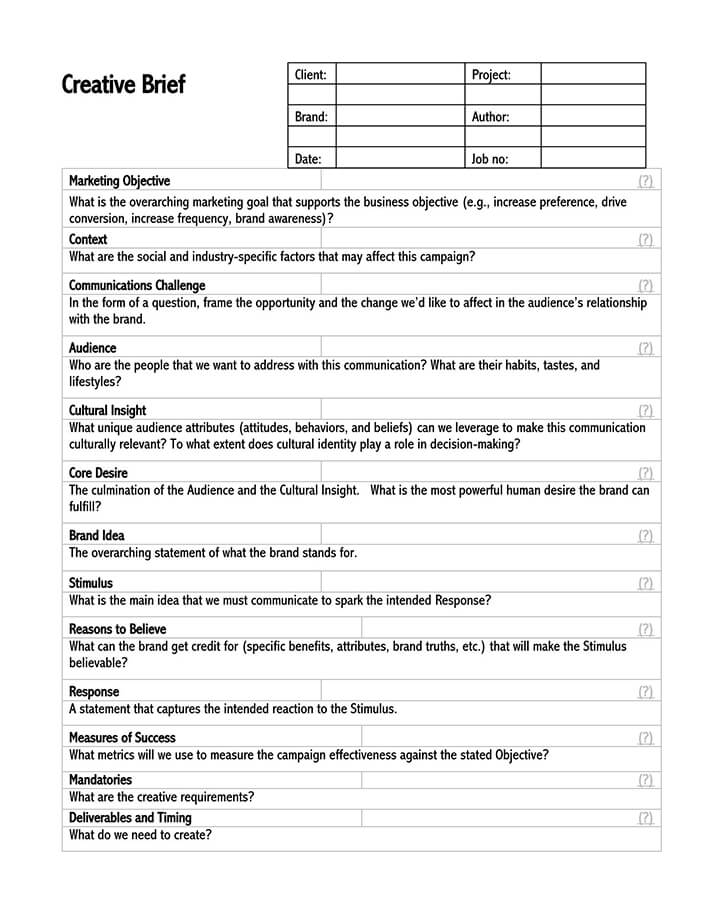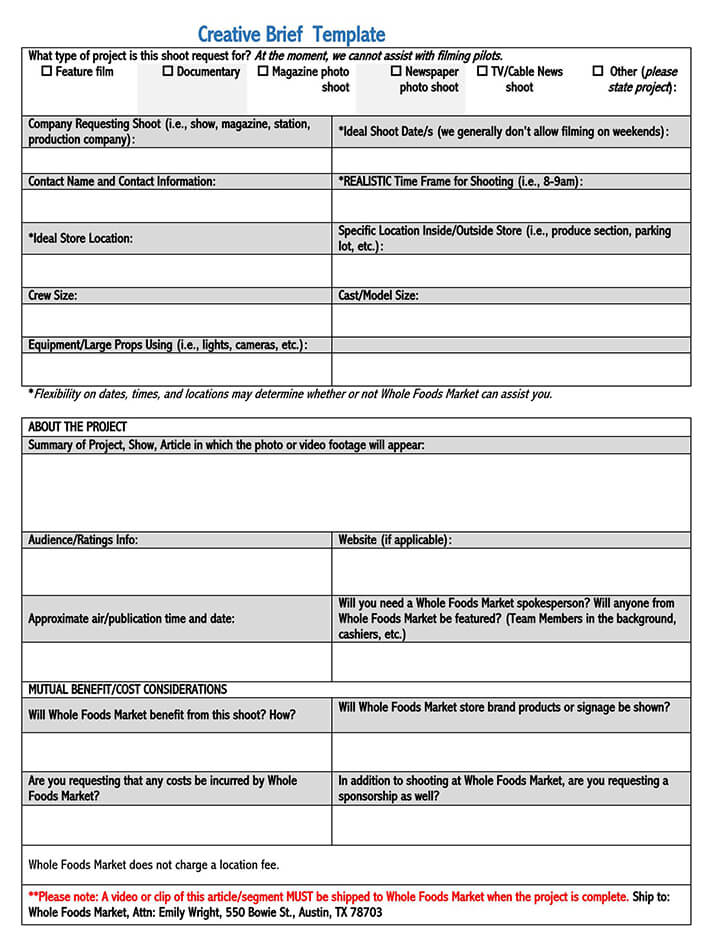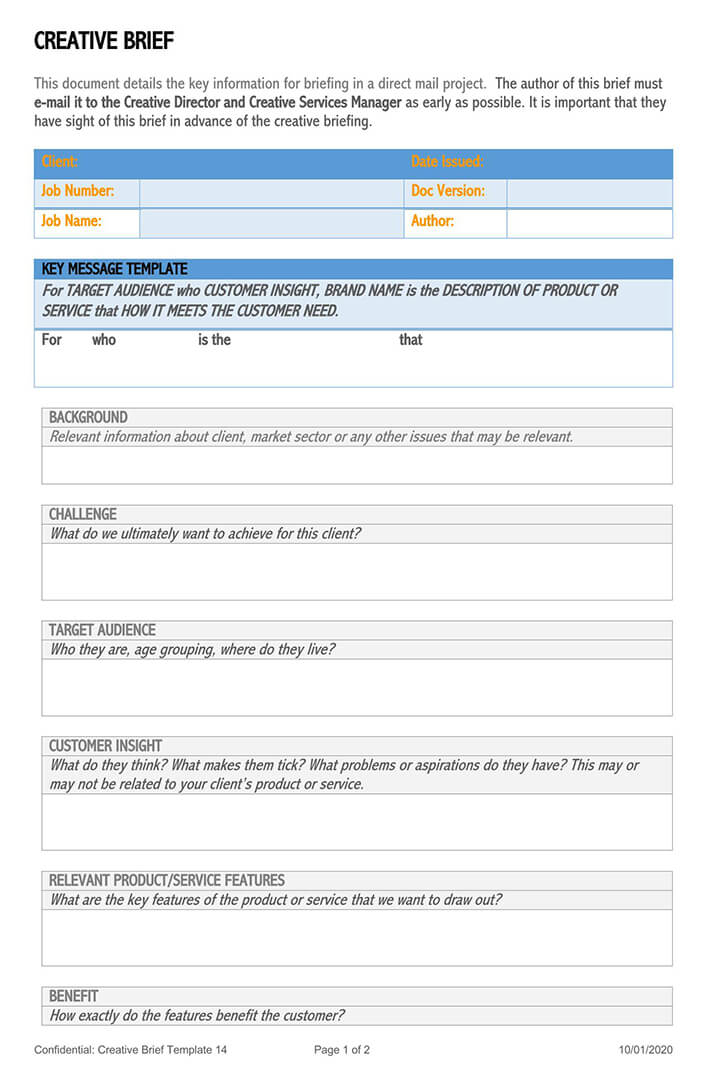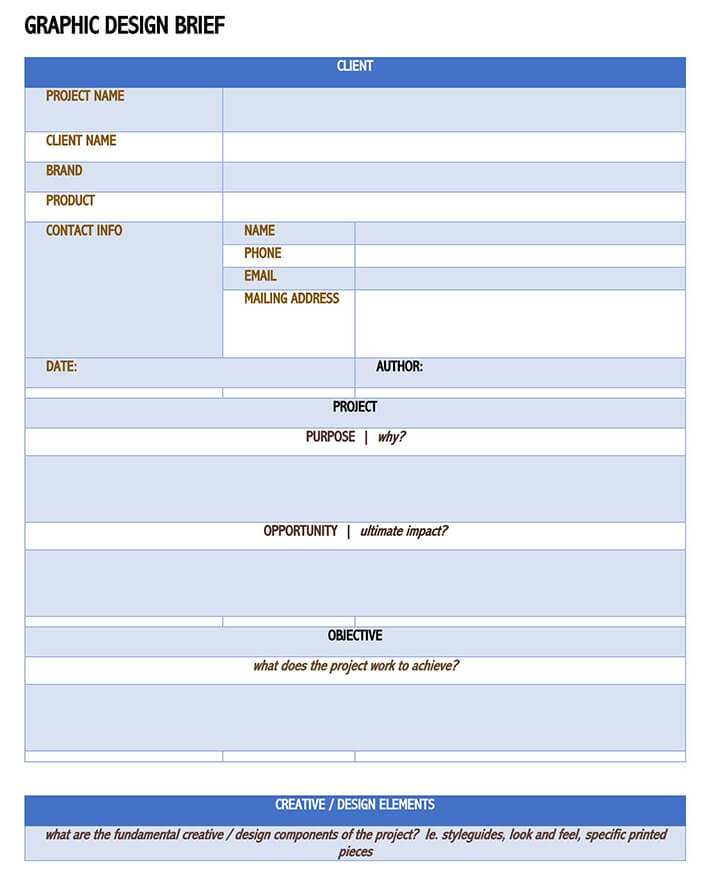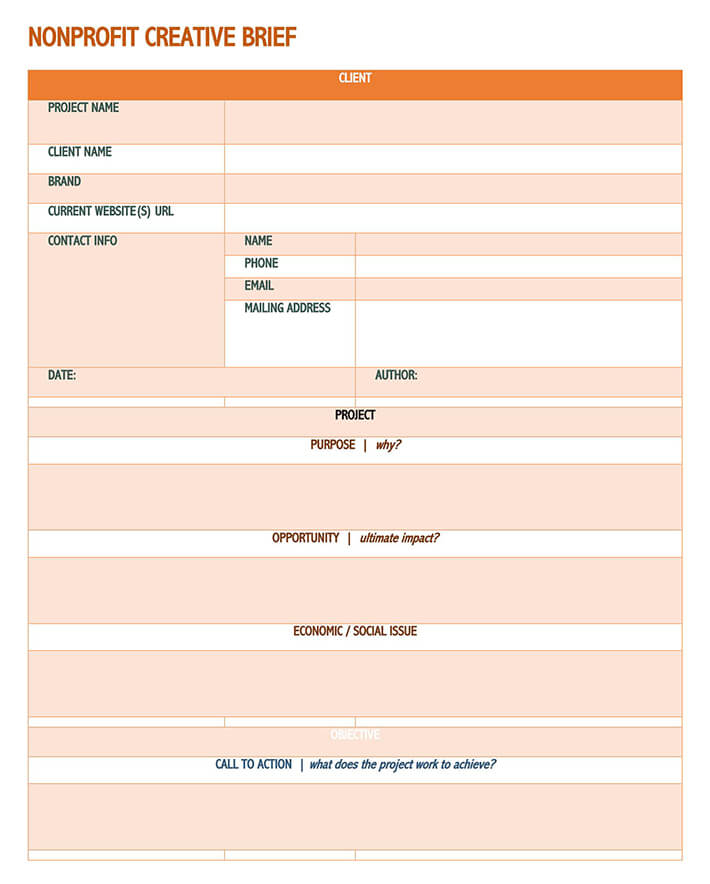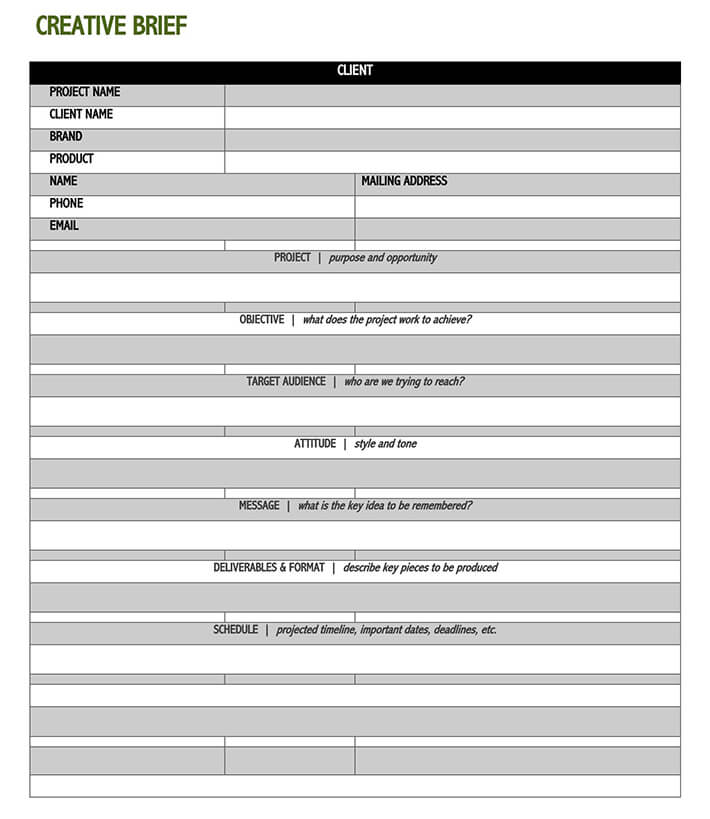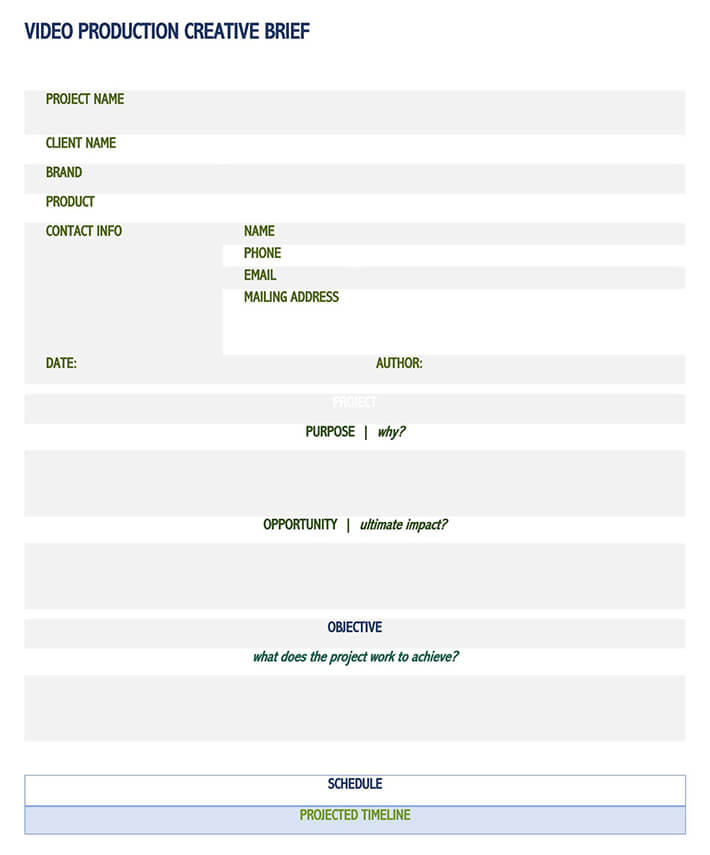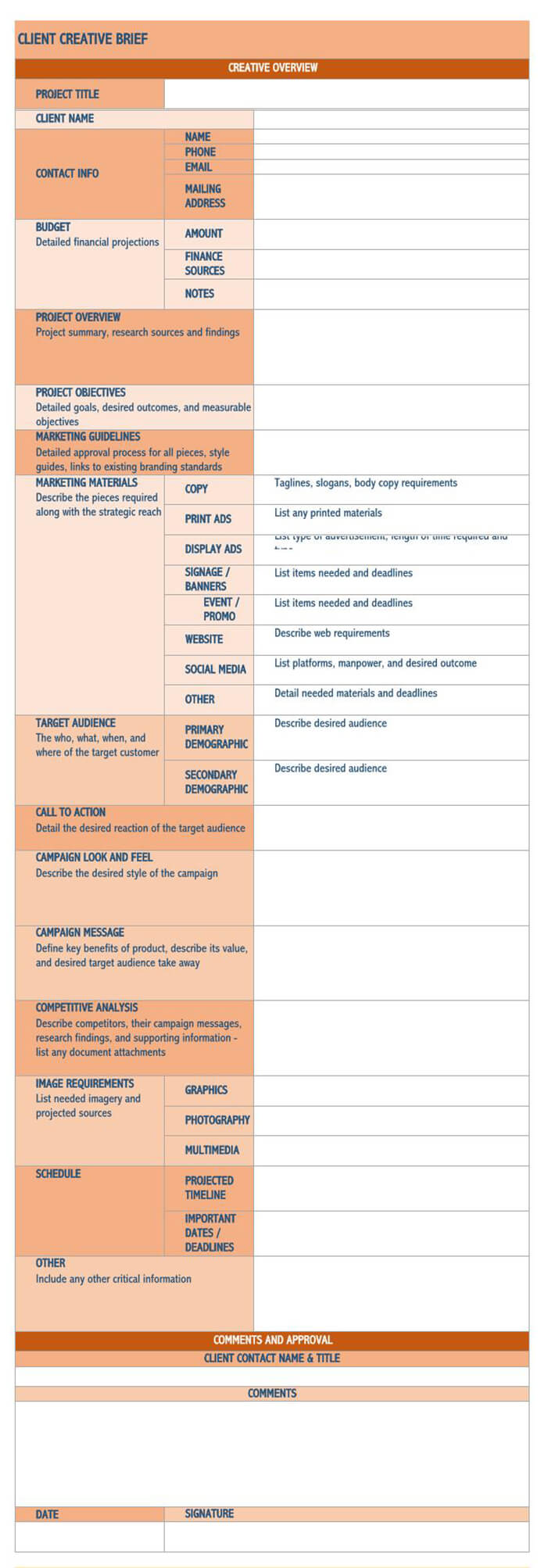In writing an effective creative brief, you may want to access a creative brief example or creative brief template to assist you in the process. It is an essential document as it serves as a blueprint for your marketing campaign. It has several different elements working together to create a project that will grab and hold the target audience’s attention.
The brief, which can also be considered as the lifeline of all successful marketing campaigns, is the most vital one-to-two-page document in the world of marketing.
It is a project document that informs clients and key stakeholders about the specific details involved in a project, such as branding, objectives/goals, demographics, challenges, target audience, competitors, market positioning, and avenues of distribution.
It is an essential communication tool to clarify various details of a project. It guides the creative team in the right direction to accomplish the tasks and complete the project promptly.
Effective briefs rely on good questions. The who, what, where, when, and how of the deliverable would be essential to clarify to make a productive creative brief.
There are various forms of creative briefs that direct teams to complete projects driven toward specific purposes. Depending on the intended function and intent of the project, the brief will have its own form, although all briefs do share a basic layout. Beyond that, some require extensive detailed information, planning and strategy information, and marketing data.
Free Creative Brief Templates
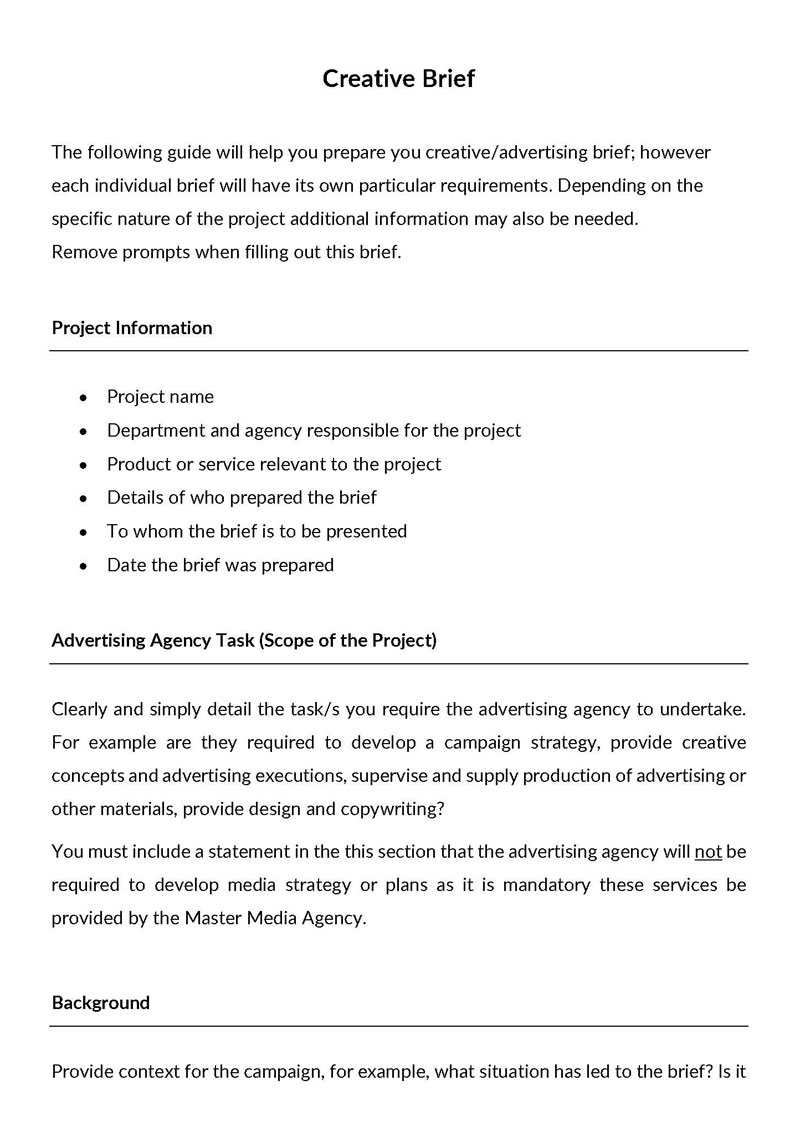
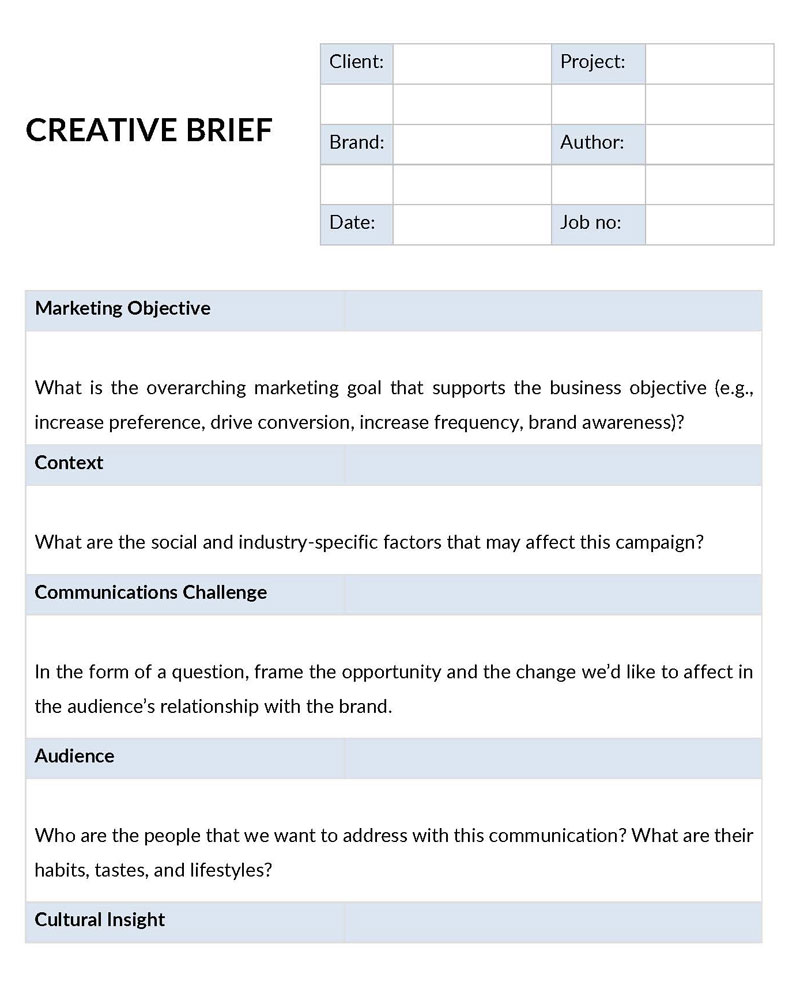
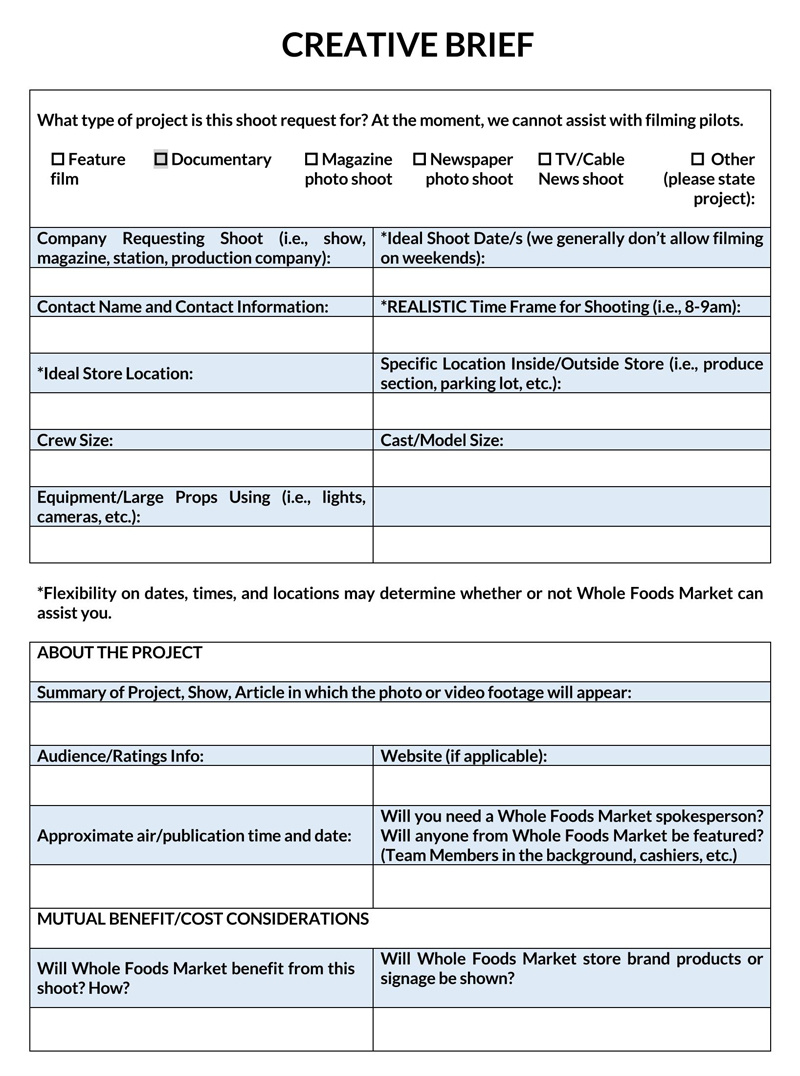
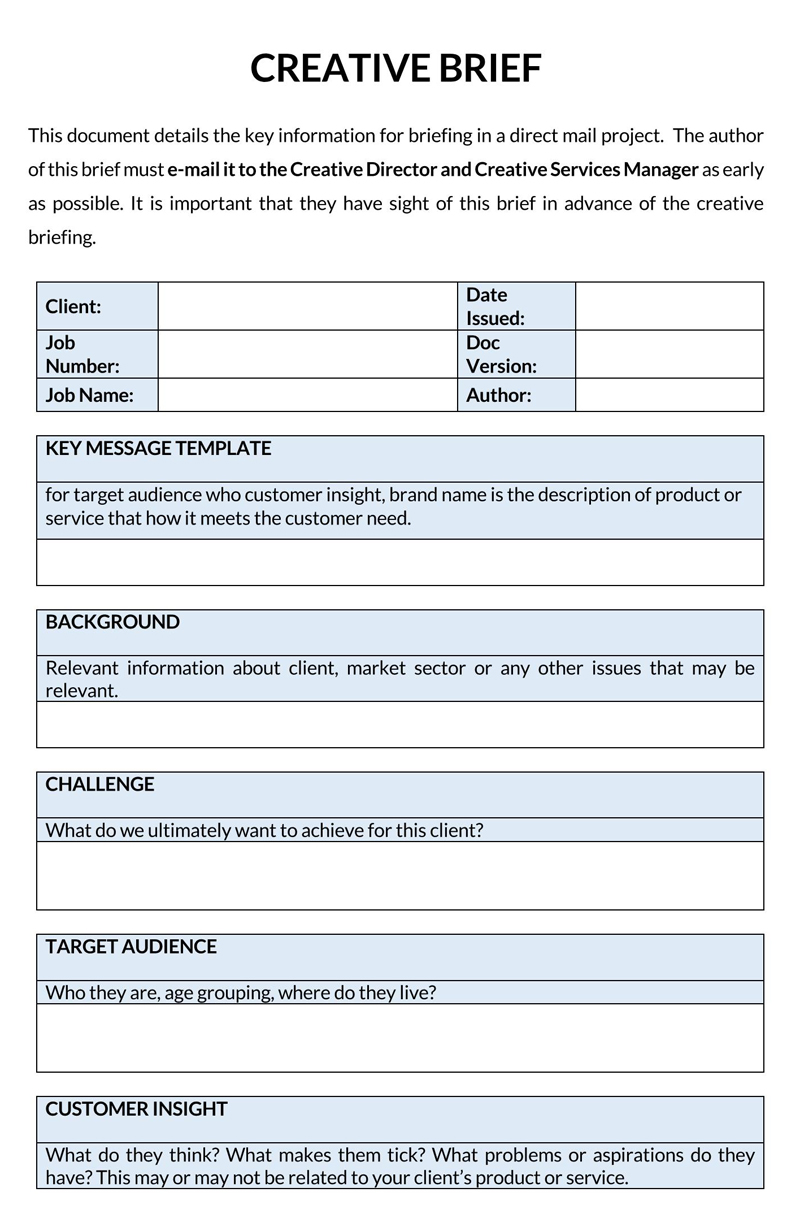
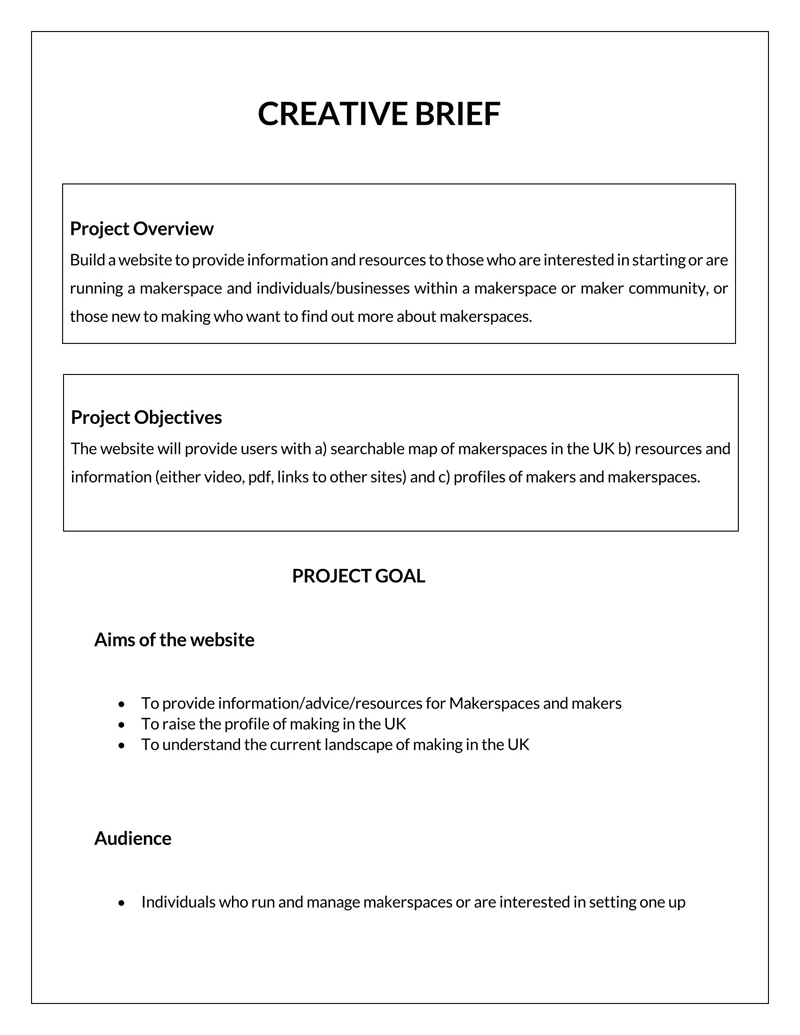
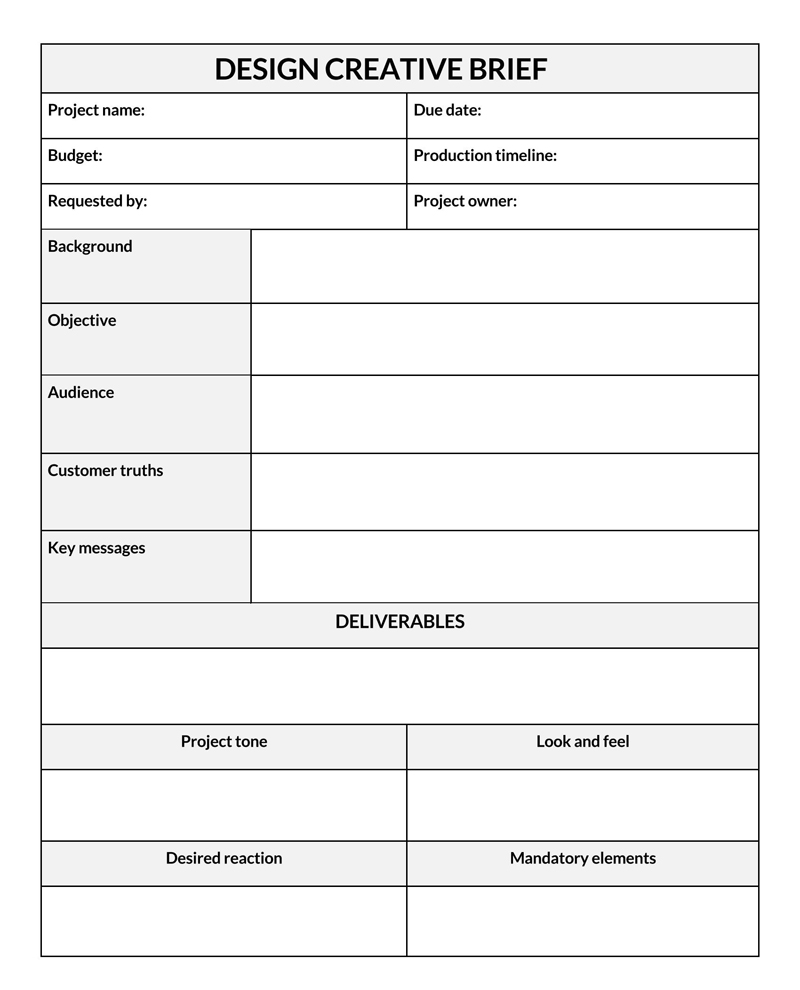
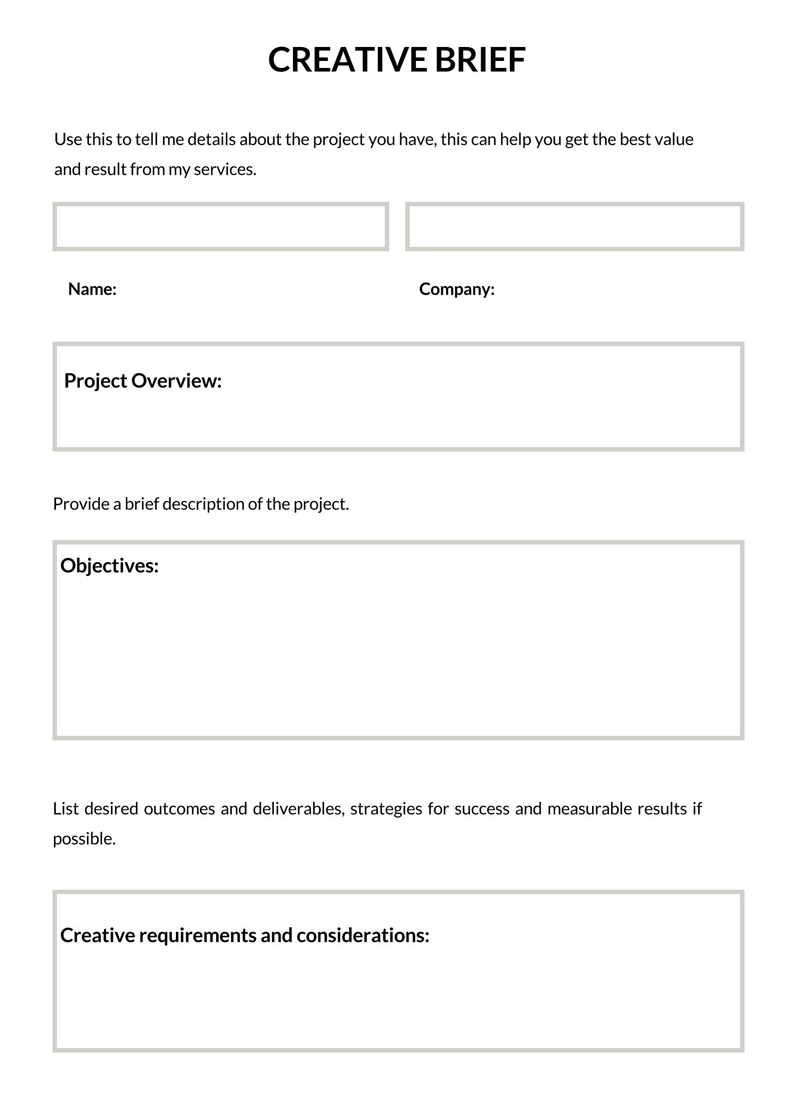
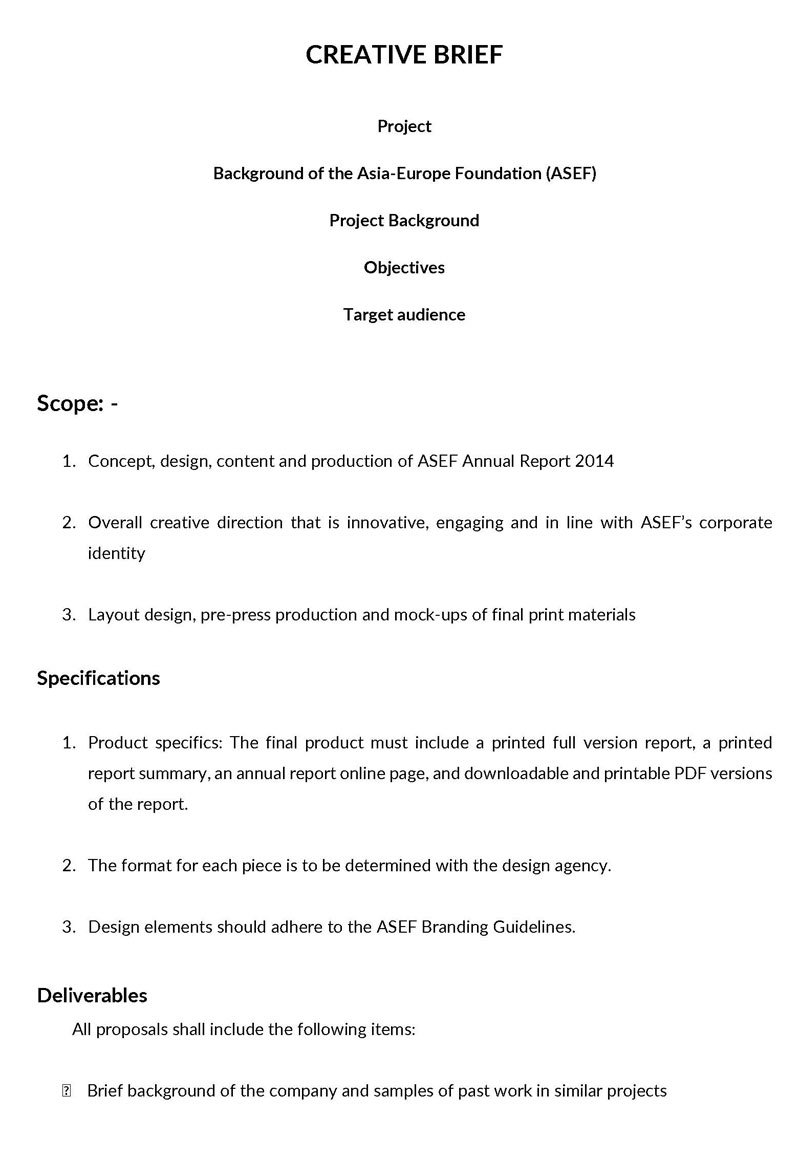
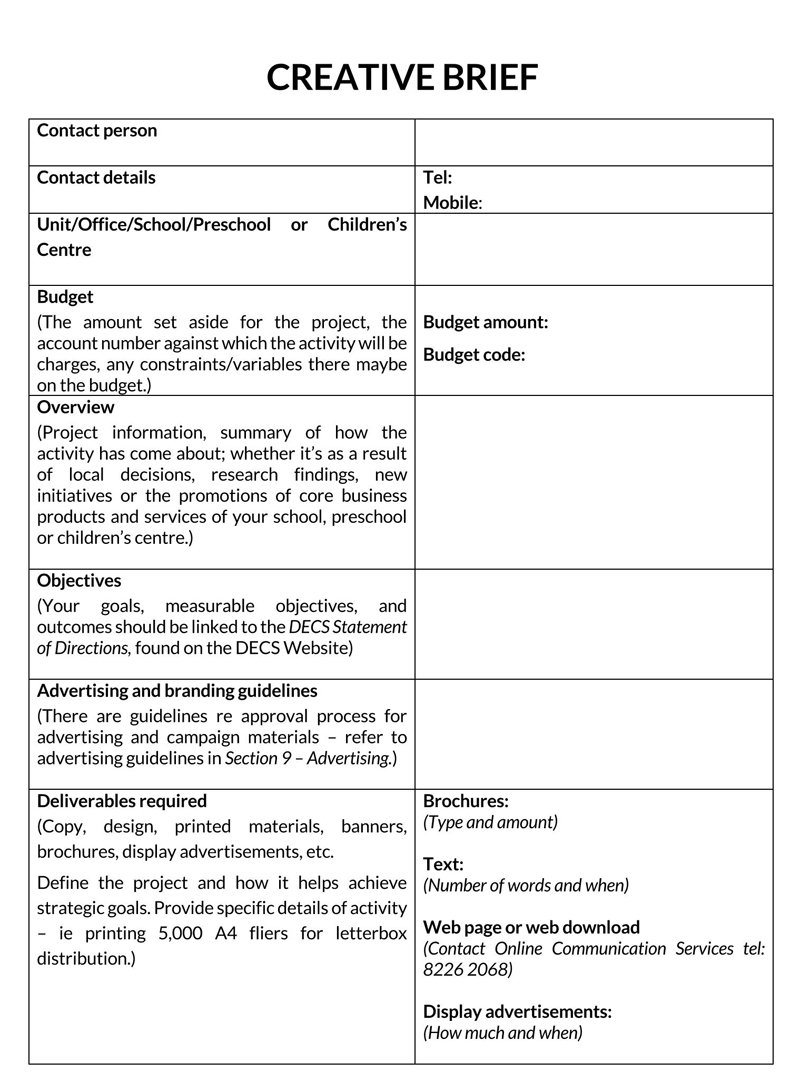
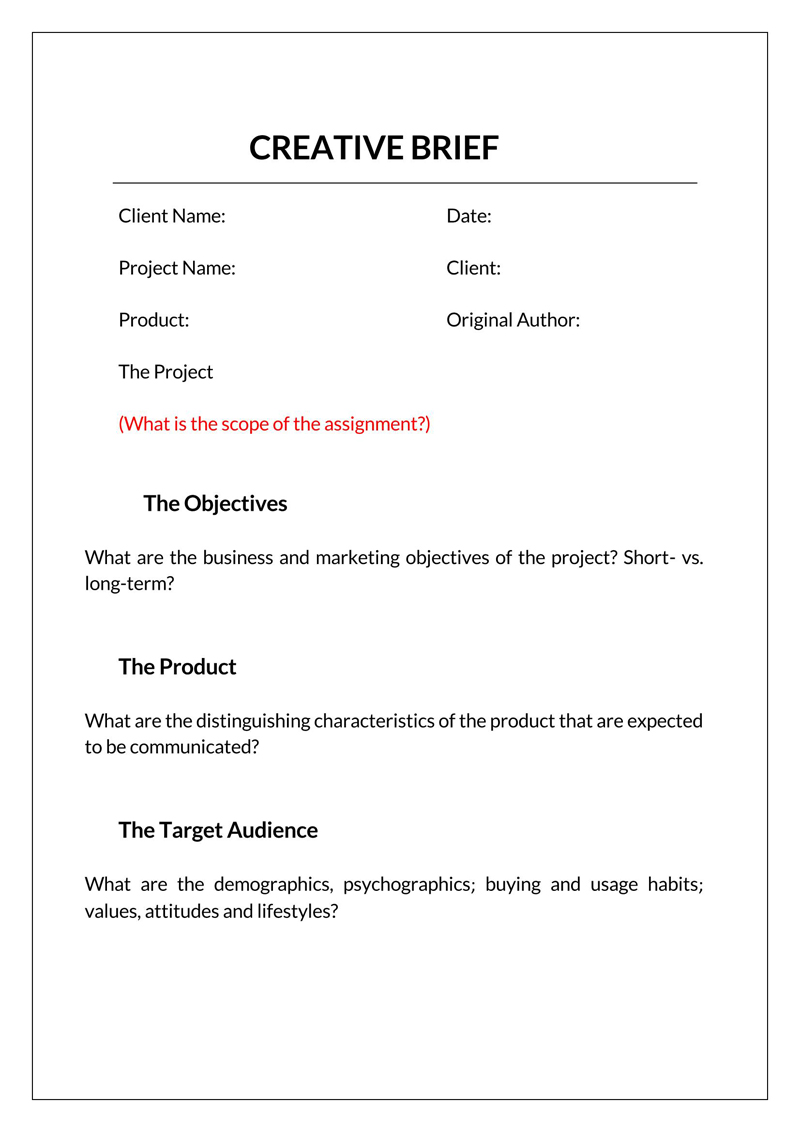
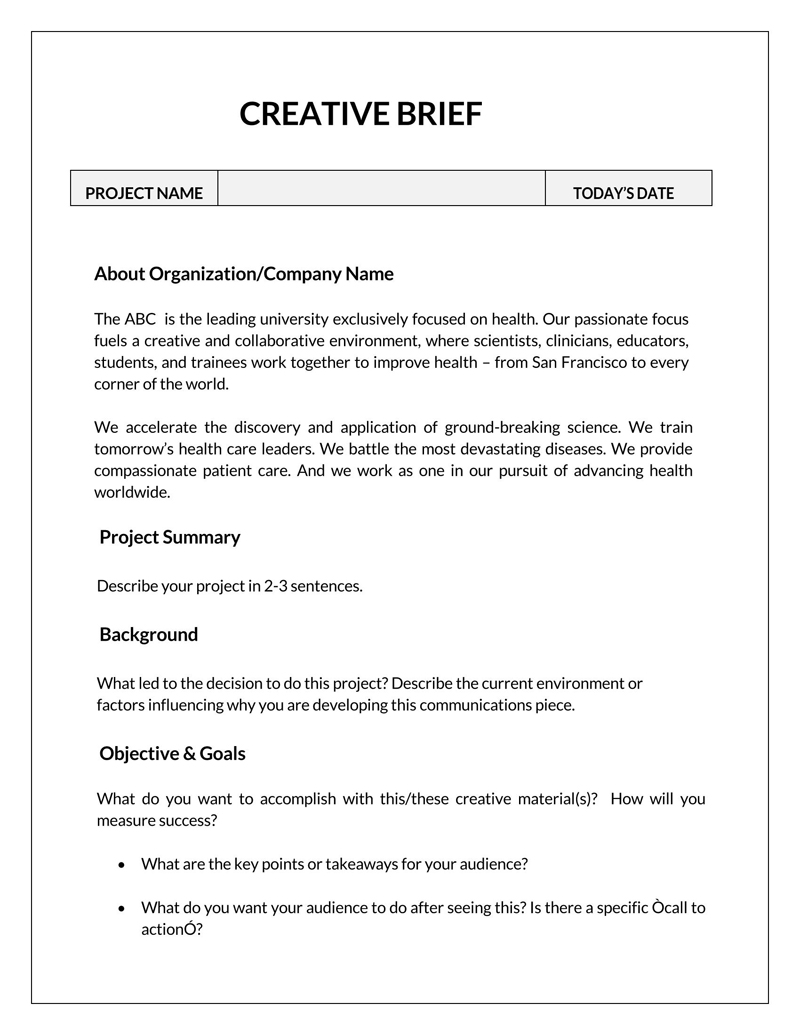
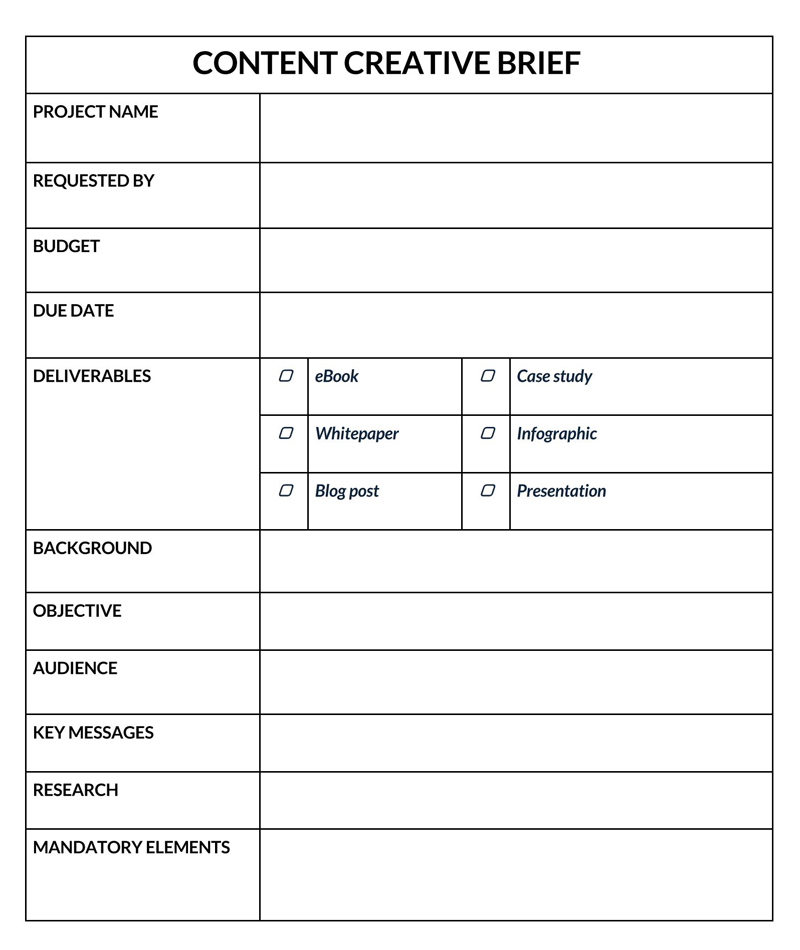
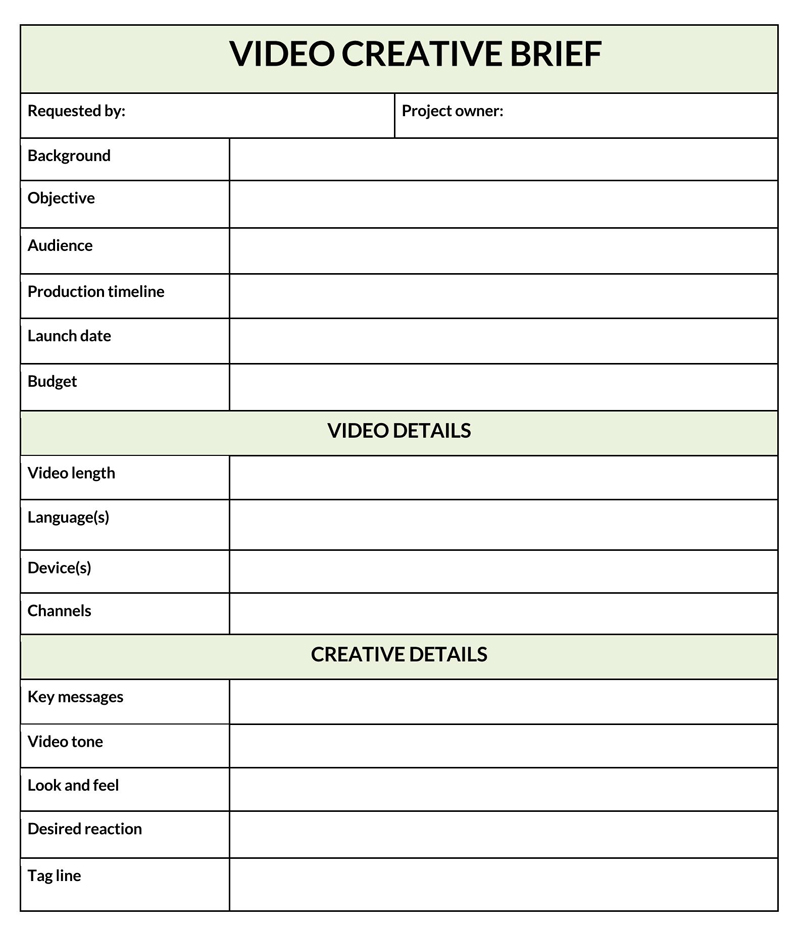
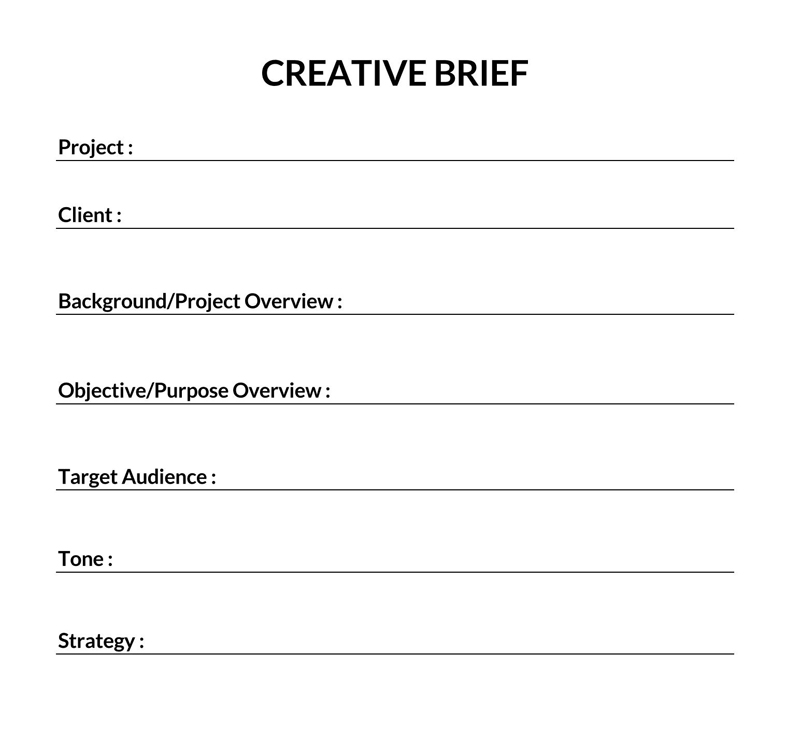
Where a Creative Brief is Used?
A creative brief is an advertising and marketing campaign document. It provides the creative team, clients, stakeholders, and other associated individuals with the information they need to strategize, target, and perform necessary tasks working as a group.
A few types of advertising and marketing campaigns that use creative briefs include:
- Online advertising
- Social media
- Promotional print and video
- Mobile apps
Elements of a Creative Brief Template
The foundation of a template is built upon the elements it contains. The product, business, market, customers, and campaign provide invaluable data that the creative team, stockholders, and agencies can use to launch a successful marketing campaign.
The product
The product you are marketing is the beginning and end of the template. Selling this product is the purpose of the creative brief. To sell it well, the team must understand it from every angle.
For this reason, customer data, market survey data, and the client’s records about the product should be included in the template. Without this information, the brief would be lacking, and the campaign would suffer.
The business
Even though the business and the product of the brief may have separate branding that overlaps, the market perception of each must be fully considered. This is because the business brand may have an independent reputation from the product brand. The marketing campaign must include this data in the brief template so that the team may resolve any marketing issues ahead of time.
The market
The market consists of competitors, context, and category. Each branch has its own influence on how the campaign moves forward. The goal here is to examine and evaluate the following aspects of each segment:
Competitors
- The identity of the competitors
- The market comparisons
- Competitors’ marketing strategy
- Competitors’ advertising providers
- The messaging and tone
- The customer data
Context
- The market perception of the product
- Evaluation of cultural shifts or events to use in promotion
- Economic state
Category
- Customer perception of the category
- What drives the perception
- Evaluation of positive and negative factors influencing perception
- Extrapolating category data to use in the campaign
The customers
Target audience is the most critical aspect to examine in a template and include in campaign communications. The customers will decide if the campaign is a success or a failure.
The template must incorporate accurate customer data. This data consists of:
- Demographics
- Psychographics
- Product perception
- The campaign’s perception goal
- Customers’ frustrations, expectations, and aspirations
- Customers’ trigger data
Creative direction
The creative direction section of the template should include information about the desired look and feel, style, and tone for the creative work. This section helps the creative team to develop solutions that align with the overall campaign objectives and the desired brand image.
Key performance indicators (KPIs)
KPIs are specific, measurable goals that the campaign is intended to achieve. This section of the template should outline the KPIs for the project to help the creative team to develop solutions that are aligned with the overall campaign objectives and can be tracked and measured for success.
Budget
A clear and well-defined budget is essential to the success of any marketing campaign. This section of the template should outline the budget for the project and include any limitations or constraints that the creative team should consider when developing solutions.
Approval process
The approval process section of the template should outline the stakeholders who will be involved in reviewing and approving the creative work. This section can help to ensure that the work meets the expectations and requirements of all parties involved and is approved in a timely manner.
The campaign
Every campaign is unique, and each has a targeted audience, message, goal, character, and tone. Therefore, overlapping campaigns for the same product can function at the same time.
The creative team must strategize and plan each campaign carefully in the context of the template. It will take careful thought, placement, and timing to be successful. These are a few thoughts to brainstorm:
- Detailed campaign motive and purpose
- The campaign’s call to action
- The campaign’s primary challenge
- Strategy
Overall message and tone
By including these additional elements in the template, the creative team can have a more comprehensive understanding of the project requirements and can develop more effective and appropriate solutions that meet the client’s needs while staying within the constraints of the project.
A well-structured and comprehensive creative brief template serves as a roadmap for the project and helps to ensure that everyone involved is aligned on the goals and approach. It is an essential tool for effective communication between the client and the creative team and serves as a reference point throughout the project. With the right information and guidance provided in the template, the creative team can develop solutions that are both creative and effective in achieving the project objectives.
Reasons and Purpose of a Creative Brief
The reasons and purposes of a creative brief are innumerable. Following are a few of them:
- You need a campaign plan. The team cannot build a successful project from nothing. It requires a blueprint of expectations, objectives, timelines, vision, and purpose. It should enlist all the necessary information and a concise, detailed look at the company’s background, goals, and the product it wants to market.
- Your creative brief is more than just a blueprint. It is the mechanism needed through which communication about every aspect of the project is facilitated. A well-written brief will also save time and money. It lays out the strategy for any campaign goal and any type of promotional endeavor.
- Through your brief, you will maintain communication and accountability. The brief communicates every aspect of the campaign to everyone involved, so there is no misunderstanding. This document sets parameters, establishes trust, and provides a platform for the team to decide on the project’s execution, objectives, deliverables, and scope.
- The brief will expedite approvals and requests because the goals, details, and parameters are organized and solidified within the document. Clarity minimizes conflict and confusion, making the approval process more efficient. Therefore, the project, team, contributors, and investors can also move forward more efficiently toward a shared objective.
- The finished product will be of superior quality because the brief clarifies any competitor data, branding information, the scope and timeframe of the project, and budget information. Through the brief, expectations are examined early in the process. Everyone on the team evaluates and agrees on the best way to resolve issues and complete the project. These elements result in a high-quality product.
Creative Brief Examples
When Should You Use a Creative Brief?
You should use an extensive creative brief when you are working on a highly conceptualized project. If your project is a previous work, needs revisions, or is template-based, an intake form or abbreviated brief would work best and result in less work for the team.
They come in various designs. Just as no campaign is the same, neither are the briefs that provide their blueprint for success. The following are the tiers, types of projects, and the briefs that may best serve them:
- Tier 1 or projects with non-standard, non-iterative, highly conceptual work can be the most misconstrued. An extensive brief performs best for this type of project because of its intense attention to detail. This will prevent misunderstandings and mistakes.
- Tier 2 or project execution of previous work across deliverables is best served by an abbreviated brief. It does not entail the intensity of an extensive brief, but it keeps the communication clear about the data involved, so there are no misunderstandings.
- Tier 3 or projects with edits and revisions or template work only need a simple brief, intake form, or checklist type of document to maintain clarity about its information. Anything more than that will be confusing and unnecessary.
Who Creates a Creative Brief?
The person who creates the brief depends on the project’s situation and setup. In some cases, an agency representative or account manager may write up the document. In other instances, the person who drafts it may be assigned by the creative team. That person is usually the project manager who collects data from team members to shape the document. Create the brief in such a way that a designer or developer can understand it.
It is not recommended to allow the client to draft the brief for several reasons. It can be a problematic and confusing document to create. Clients often take too long to draft it and become frustrated. An added obstacle is that clients regularly do not supply complete information.
For Whom is the Creative Brief Made?
The brief is made for the creative team to keep everyone on the same page about every aspect of the project, driving the campaign forward with the client’s vision in mind. The client’s vision should be interpreted in such a way that it is accessible to the creative team. It is written clearly and concisely so the whole team can glean information and work together toward a shared goal. This means no jargon, no fluff, and no ‘marketer-speak.’
At the same time, the brief is not the answer to the client’s problem; it’s a starting point to inspire your team. It should have just enough insight to challenge your team and get them to think creatively about the problem.
How to Write a Creative Brief
Naming your campaign is the first thing you need to do when writing a creative brief. The name should be concise and clearly direct what the project is about, so there is no confusion when the title comes up for discussion.
Step 1: Introduction
The introduction to your creative brief should define the background or profile of your company, brand, or business. It should also describe your project and purpose of communication. This allows the team to get a glance at what your business is trying to accomplish.
- Define the background or profile: The background or profile of each of these should be one or two sentences that clearly state where the idea for the project originated. The team would be interested to know if the company had similar projects in the past, the reason for creating the current project, and whether the current project is a response to a recent event or change in the market. The background or profile information is a statement that lets the team understand the client’s project history and intent for the current project.
- Define your project: This information will help the team understand your demands and expectations on deliverables and define the end goal. It will also shape and structure the branding and the marketing strategy for the campaign. Defining your project will share your vision with the entire team.
- Define the purpose of communication: For the project to succeed, the creative brief must define the purpose of communication. It needs a clear and driven purpose that is measurable and connected to the main challenge of the project. It is explained in terms of what the client wants to do with this campaign. It needs a distinct and unique mission.
Step 2: Your target audience
It must state what your target audience is for this campaign. This is the consumer-based step that will engage and make your project a success. When determining your target audience, you want to consider demographics, customer behavior, trends, psychographics, and geographics. Because this section of the brief can be quite lengthy, it might be best to use a buyer persona document to accompany your brief.
Step 3: Objectives and challenges
Specifying your objectives and challenges is imperative. Your creative team must understand what the project wants to achieve and any possible obstacles that may emerge.
- State your main objective: Your main objective for the project is the central goal of the campaign, and this is the whole reason the project exists. There must be valuable substance to the main objective, not just hopes and dreams. Once the main objective is established, then design options may be added.
- Define your voice: The voice and tone of your project need to be described with adjectives that have an emotional connection. The words you choose will have an impact on how the message is received. When combined with the message, the voice will speak directly to the target audience, persuading it to respond to a call to action.
- Give details of your brand or campaign: Stating the details of your brand or campaign in the brief helps everyone on the team. However, it is especially valuable for external agencies to understand the specific details you expect. It includes information such as logos, fonts, trademarks, colors, and other brand-specific information.
- Define your budget: It is important to define your budget within the creative brief. A budget breakdown or estimated budget helps the team to understand any constraints or parameters the budget dictates.
- Highlight possible challenges: It should simply state the key challenge against the product brand without a long explanation. It should also present the primary and secondary challenges the target audience may find and recommend how the product, project, or campaign can solve those problems.
Step 4: Walk through a competitive landscape
When you include competitor data in your brief, you are shoring up your position in the competitive landscape. If you choose to incorporate this information, be sure the comparison and contrast add significant value to your product.
Step 5: Action plan
The action plan guides the team in the direction you want the project to proceed. Disclosing parameters, boundaries, decision-makers, messaging, technical requirements, and due date information sets the campaign up for the best strategizing methods, calendaring, and overall clear communication.
- Define your scope: Your scope is the set of parameters of your campaign. It includes expectations, budget, and due dates. It is an overview of basic information to let the team know where the boundaries fall. It will also prevent confusion, overspending, and obstacles in strategy.
- Note your stakeholders: Presenting your stakeholders in the brief allows the creative team to know who they are working with, the decision-makers, and the hierarchy of who makes approvals.
- Offer a brief distribution plan: The distribution plan should be included in the brief. It indicates the media outlets or platforms on which the campaign will launch. It also reports a plan for promotional content.
- Nail down the key message:
The key message is the primary idea the project must communicate to the target audience. All the stakeholders will decide together the content of this message. It must reach out and grab the target audience and make them pay attention to the campaign.
- Include any technical requirements: Listing the constraints of any technical requirements will prevent problems in the project later down the road. Be sure to incorporate brand guidelines, budget issues, and deliverable dates to avoid delays or issues with launching your campaign in a timely and cost-efficient manner.
- Include due date information: Stating the due date information in the brief optimizes the whole team’s calendaring, planning, and strategy efforts. From the due date, all other deadlines can fall into order in an organized fashion. This prevents confusion, missed deadlines, and costly mistakes.
Step 6: Share the brief
After a draft of the brief is completed and shared with the team for feedback, it can then be polished to improve its effectiveness. Sharing the brief is vital for clear communication, conflict resolution, and ultimately, a successful marketing campaign.
- Effective practices for writing a creative brief: The most effective practices for writing a creative brief result in a short document that explains the brand, the target audience, and the key message of its campaign. The following are the three top suggestions for the most effective practices for writing this vital document:
- Be thorough but concise: It should be brief. It should be accurate and to-the-point information without lengthy descriptions or details. It serves as a footprint of the project data, so anyone on the team can quickly and easily understand it.
- Focus on measurable results: For the team to grasp the project goals, the intent and objective must be measurable. Loose ends and unclear results or a lack of stated results only cause confusion.
- Get input from your team: Teamwork is essential to success. Therefore, it is critical to involve all team members in collecting information for the brief. It is the only way to ensure that no data was left out or that any team member was excluded from the opportunity to participate.
Conclusion
The creative brief is a fundamental necessity for large marketing campaigns with extensive detail and information. An abbreviated version is essential for smaller projects. Either way, it is a marketing document you certainly want to master if you have campaigns to launch or are part of a creative team.
We have templates available for your use. These free downloadable documents can help your team make your marketing campaign a success.
